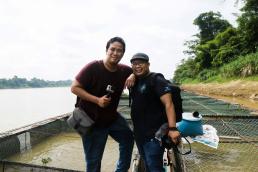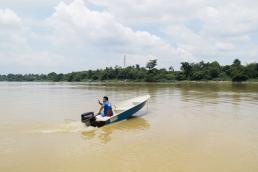“Fish caring isn’t complicated. You only need to feed them twice a day. Once in the morning, and then in the evening”.
Zahari Zaidi, 45, has been in the Patin fishery business for eleven years. Together with his brother, he runs Lebak Patin’s Garden, one of the many Patin farms along the Sungai Pahang. It was 10 A.M. in the morning. Zahari gestured towards the dozens of cages submerged beneath the murky waters.
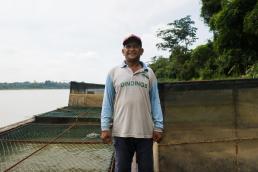
Ikan Patin, while not exclusive to Temerloh – has its identity associated closely to the river town. So intertwined is the freshwater fish to the town, that in 1990, it was declared Bandar Patin or Patin Town. For decades now, visitors from neighbouring states and cities take weekend excursions to Temerloh to enjoy its star dish, Ikan Patin Masak Tempoyak.
But Zahari does not discuss the dish much. His passion is in fish farming and its intricacies. When asked about what makes the Patin special compared to other freshwater fishes, he describes the flesh as “sweet, and does not smell fishy or muddy”.
However, when asked about how Ikan Patin in Temerloh compares to ones that are reared in other Pahang districts, he laughs knowingly but does not answer the question.
The Patin fish farm is a simple set-up. It is a motley of cages, assembled and harnessed together with planks of wood and tub floaters. When we took our first steps earlier in the morning, we took great care to not accidentally lose our balance and tip into the river. Zahari says that over the years, visitors have lost their phones to the murky depths of the Pahang River.
“How deep is it?”
“Oh, don’t worry. Probably up to your chests on a normal day,” he assures. Thankfully, none of us fell into the river and neither did any of the items we carried. Once we got the hang of our “river legs”, navigating the narrow planks of the floating fish farm was not a problem. In the background of our conversation, two of the workers walked along the fishery, examining for structural integrity and to make sure the cages were tightly secured.
Zahari says that the cages are secure but indicates rare occasions when they break free and float away. This typically happens during the year-end floods. During these times, Patin farmers would do maintenance checks on their cages – whether it is replacing ropes or fixing the cage wirings – and bring the cages close to shore.
In 2014, there was an incident where the ropes snapped. The cages, along with the Patin fishes it in drifted far down the river. This is no small matter, as the profits reaped from a single cage can go up to RM10,000.
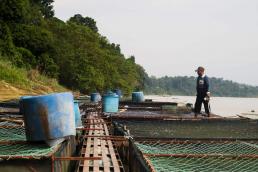


When discussing the economics of Patin farming, the numbers vary depending on who you speak to – as the practice is also dependent on factors such as fish seedlings, pellet types (also known as dedak), and the number of cages in a farm. Zahari started out in the business with ten second-hand cages, which he repaired over a period of time until it was usable.
A single cage of fish produce can cost up to RM5,000 in total. Comprising of fish seedlings, pellet feeds, periodic maintenance, and monitoring of the fishes’ health over a period of roughly seven months. For a farmer just starting out into the Patin business, that is up to seven months of waiting for a return on investments – all while at the mercy of the environment.
But when the fishes grow into maturity, it is payday.
“A tonne can sell up to RM13,000, and I sell in bulk, obviously”. Typically for Zahari, he makes a sale of 800kgs to a tonne (1000kgs) every cycle. In a year, a Patin farmer can expect up to one or two cycles.
Profits, however, have been on a steady decline. “Nowadays, farmers only get about 30% less than what they used to” Zahari laments. The Patin business is not as “profitable” as it used to be but Zahari is grateful that the revenue is continuous despite the tides of time. If given a chance now, Zahari shares that he would not start a Patin farm.
Despite his disposition, the demand for Ikan Patin continues to increase yearly. The problem is that there are not enough suppliers in Temerloh. This is especially true for those who supply to restaurants in Kuala Lumpur. So great is the demand for Patin that it has even garnered international interest. Earlier this year, the Pahang Chief Minister indicated plans to market Ikan Patin to the Middle East, with policies in place to encourage the growth of Patin fisheries in Temerloh to meet this expected demand.
Proof to Patin’s international appeal was last year when the Kuala Krai Cooperative Investment group in Kelantan entered an agreement with Saudi Arabia to supply Ikan Patin abroad. This was part of Kelantan’s economic initiatives to improve the state’s aquacultural industry. This agreement is estimated to receive revenue of RM80 mil to RM100 million annually, in exchange for up to 40 containers of Ikan Patin.
So certainly, demand exists for the fish.
Far away from macroeconomic concerns and international trade exports, the local price for Patin fetches for RM13 per kilogram but is typically sold around RM17 to RM18 per kilogram. While the base price of RM13 is agreed upon in the Patin Temerloh cartel, the retail or wholesale price tag usually differs and is the source of competition among the Patin farmers.
We saw this for ourselves when we visited one of Lebak Patin Garden’s road-store. The price on the board indicated RM18 per kilogram, with two fish tanks at the front of the store. One housing Patin, and the other Talapia. The store is numbered 22 among the countless others in the area. In the few hours we hung out there, there were families who stopped every fifteen minutes or so to purchase a pack of fresh Patin.



This was the Patin industry realised among the grassroots. International trade deals meant little to those who operated these roadside stalls and the Malaysians who patron them. What mattered was the level of trust one had in the Temerloh brand of Ikan Patin – which is a strong reason for its decades-long survivability and mainstay appeal.
It mattered too, that a customer could see for themselves from the riverbank, Patin farms rearing fresh fish by the millions. With a local face to put to the trade. None of that frozen nonsense, and certainly no faceless corporation profiteering off a beloved fish.


When it comes to Patin farming challenges, there are usually two: the fish, and the environment. Ahmad Shahriman Ishak, a Patin farmer and restaurateur of Makan-Makan Patin D’Bangau boils it down to the foundation of the trade itself: the fish seedling. “Illnesses, disease inflicting the fish is a fact of the business. That cannot be controlled. However, the success of this trade is very dependent on your seedling”.
The seedlings are often obtained at the fry stage when the fish is about 1-2cm long. This is what fish farmers refer to when they call it by the Malay term, benih. Shahriman says that the risk of death among Patin produce is highly dependent on the quality of one’s seedling. He shares the story of a time when he lost 300kgs of Ikan Patin.
“They are fine when they are small but when they grow up, it’s inevitable that at least a number of them will die”. He gives a rough estimate. If one were to start off with 1,500 kgs of Patin seedlings, then they should expect around 800 to 1000kgs at the end of the cycle. When asked if there was a cure or vaccine to manage with these infections, Shahriman nonchalantly replies a solid no.
Zahari shares the same story of yield loss, saying that he has noticed an increased incidence of infected Ikan Patin in the last four years. “Sungai Pahang’s waters are no longer as clean as they used to be”.
The waters that day was already very murky with no visibility. Zahari jokes that it is usually a lot worse. “If not, it’d already look like [over brewed] tea”. He speculates that the quality of water has to do with mining, logging, or soil-related activities along the Pahang River from the northern side of Jerantut or Lipis. What Zahari earlier claims as a geographical advantage to the Patin quality, is also its weakness – as Temerloh sits at the confluence of three streams of the Pahang River.
Although he and a few others have raised this issue in 2016 with several different state departments and agencies, there has been no visible action nor feedback since. Loudest among the voices of the Patin farmers when it comes to this issue, however, is Khaidir Ahmad. The former journalist turned Patin farmer is a vocal environmentalist and often does exposés on illegal logging or development activities within Temerloh.
Khaidir often finds himself at loggerheads with the Pahang state government, who find him to be a thorn on their side. So much so, that he was sued by an officer of the state government in 2017. Khaidir was then exposing an illegal soil pumping operation that he links to the major losses suffered by Patin farmers in the Lebak district of Temerloh. There was alleged pressure from state authorities to silence him, resulting in an official notice to dismantle Khaidir’s Patin farm. To this day, Khaidir continues his environmental activism – occasionally posting exposés on illegal logging, farming or mining activities around Pahang, but primarily in Temerloh.
Environmental pollution, throughout the entire time we were in Temerloh, was a constant discussion when it came to the Patin trade. Shahriman shares a time when floating logs and driftwood from logging activities broke his cages, especially during floods. Zahari however, was incredibly concerned about how chemical poisoning in the water, due to mining or farming activities – is impacting the health of his fishes.
“There are biological and chemical complications here. Bacteria in the waters could infect the fishes – either from factorial waste or chemicals from vegetable plantations.” There is an acknowledgement that due to the expansive length of the Pahang River, agricultural or industrial activities of all kinds are to be expected. Zahari’s disappointment is that is it at the detriment of his and other Patin farmers’ livelihood.
There is a disquiet as Zahari goes to one of the cages and points towards a few floating fish carcasses. He takes a few out to show us. “Usually, you would have to bury them”, he says. Another method is to burn the carcass. Both are laborious compared to tossing them into the flowing river but are done to prevent monitor lizards from being attracted to the cages – and chewing into them for a meal.
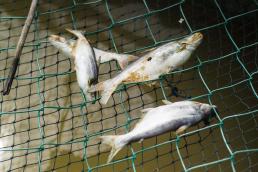
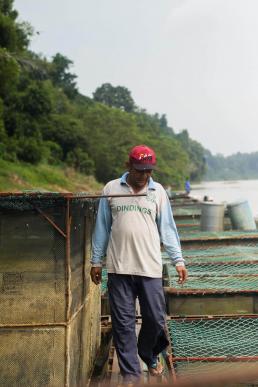
Monitor lizards, however, pose little problems compared to thieves. Shahriman says that theft is common and typically happens around 4 AM to 5 AM. Some farmers speculate the theft activities to be the work of a syndicate, causing major setbacks to Patin farmers who spend months rearing the fishes. In another interview, Zahari has once said that the thieves keep a lookout for the farmers’ movements and activities, and strike after the farmers have gone home.
The thieves had lifted the fence wire and cut the net below, before luring the fish to one corner of the square cage with feed pellets. Once the fish started to gather food, they threw a net or lift them using a scoop net.
– Mohd Rizal Ahmad, New Straits Times (2018)
Despite all these challenges, both Zahari and Shahriman still find themselves enjoying Patin farming. Zahari confides that he used to work in the civil service and several blue-collar jobs but left because he “cannot accept orders”. He finds satisfaction in self-employment as well as the security that comes with the Patin business. “I used to makan gaji and will have to wait monthly”. Patin farming, though challenging, promises constant revenue and one that is financially rewarding despite claims of decreased profits in recent years.
In between the conversations about the Patin trade, its intricacies, and politics, Zahari jokes often but is also very careful with his words. He offers advice on a healthy lifestyle, pointing out the sedentary nature of an office job and its impact on one’s physical health. “The Patin business keeps me fit and busy”. He shares his daily routine, starting the day by sending his children to school. He then goes to the fishery and begins a checklist of tasks which involves feeding, discarding carcass, and floating trash. By afternoon, he goes home for lunch, fetching his children along the way. In the evening, he returns to the fishery. If there is not much to do, he does what anyone who lives by a river does: he grabs a rod and goes fishing.
This is Zahari, day in, day out. It is a life that he is content with and has been for the past decade. He ends while wistfully looking into the distance. One of his workers come to fetch us on a speedboat to bring us back to the riverbank. As we sped away from the floating Patin farm, we said our goodbyes. He raised his hand in return, took a long drag out of his cigarette and continued attending to the fishes.

It would be remiss to visit Temerloh, discuss its Patin industry but not sample the star dish of the town. Patin Masak Tempoyak is what draws visitors from all over the Peninsular to the sleepy river town. It was high noon and the sun was scorching above our heads.
When we asked the locals for recommended Patin Tempoyak outposts, we were directed to Bangau, a bay located not far from the town centre. If one were to do an Internet search on the best Patin Tempoyak restaurants, the list would be long, and plenty has received accolades in terms of Internet reviews and media coverage.
A local we spoke to, however, cast doubt on the public listing. “There are certain places that are famous, but locals won’t go there because we know that they don’t source their Ikan Patin locally. They source it elsewhere.”
Whether this was an argument of local pride, competition, or politics – when we passed by several of the top-listed restaurants, many were full. Convoys of cars and motorbikes spilt out into the main road. In such places where years’ worth of reputation breed popularity, there is always an expectation that quality would suffer. This is true enough for most eateries that become commercial successes and needed to serve large, hungry and expecting crowds.
The Patin Tempoyak restaurants in Bangau bay, while well-known, had allegedly not suffered the same fate of those located in the town centre. If in doubt, always trust local recommendations.
The road to Bangau was narrow and barely accommodated two cars. It was almost 2 PM and we settled for a restaurant along the road named Makan-Makan Patin D’Bangau. When we arrived, there were groups of bikers seated under a rumah kampung by the dozens. Like other restaurants we noticed along the way, the eatery was full but did not seem over-commercialised.
Makan-Makan Patin D’Bangau restaurant is run by two brothers: Ahmad Shahriman Ishak (left) and Shahrul Nizam Ishak (right).

Both brothers were already operating a Patin farm nearby but had only recently got into the restaurant business in the past two years. “We get a lot of biker groups who come here. They usually share it in their [Whatsapp and Facebook] groups. That’s how we get a constant crowd”. He gestures towards the variety of motorcycles that crowd the entrance of the restaurant.
Shahriman is the more soft-spoken among the two brothers, speaking gently and with care. Shahrul, the younger brother was stoic – staying mostly silent as he allowed his older brother to share his passion for both Patin farming and running a restaurant. Shahrul however, was mostly responsible for dealing with catering services. Just last week, they had a catering job in Kuala Lumpur to serve for an NGO’s small event. That was dealt with mainly by Shahrul.
Shahriman appears more tethered in the local aspect of the business. “I work in the local council. The Patin farm we have here is managed with friends, while I run this restaurant with my brother”. The Patin trade, for Shahriman, appeared to be a side-business to supplement his day job as a civil servant.
Despite that, Shahriman is well-versed with Patin culinary. “To cook the Patin Masak Tempoyak dish, you make the gravy first. Only in the last hour do you then put the Patin in”. This method is to preserve the fish since Patin flesh is soft and easily disintegrates. Cooking the Patin along with the Tempoyak gravy from the very beginning will only break down the fish – which loses the entire point of being able to enjoy both the fish and the gravy. The inclusion of Ikan Patin in the final stretch of the cooking process allows the fish to infuse flavours while still maintaining the integrity of a semi-solid bite into its soft flesh.
Tempoyak is made from fermented durian, which automatically makes it a contentious condiment. Durian, after all, can be polarising – what more when broken down into a strong, nutty, flavourful, and spicy sauce only enjoyed by those with an acquired taste. The Temerloh community had found the secret balance in their local produce, the Patin and a cultural, generational condiment, the Tempoyak.
Tempoyak’s notability has also earned it international appeal. In fact, the Malaysian Agricultural Marketing Authority Director-General compared tempoyak’s cultural marketability to Korea’s kimchi. In last year’s China-Asean Expo (CAEXPO), samples of sambal tempoyak had sold out within the first two days. The appeal for durian and its produce goes beyond just the gravy, as China, in recent years had grown an interest in Malaysia’s durian industry. Before the coronavirus pandemic, Malaysia was shipping 1,000 tonnes of durian monthly to China. The exports were expected to contribute around RM 500 million (US$120 million) annually.
Another dish Shahriman presented to us was Patin Pekasam. Unlike Masak Tempoyak, the pekasam dish was born out of a Malay traditional preservation technique done with rice, a generous amount of salt – and for flavour, asam gelugor. The result is a dry but powerful dish, which Shahriman generously topped with sauteed chillies, onions and freshly-cut lime. A few seconds after your first few chews, you are arrested with a flow of flavours: spicy, salty, sour, and rich all at once. Though he did not verbalise it, it was clear that Shahriman preferred Patin Pekasam as he personally brought it to our table to sample.
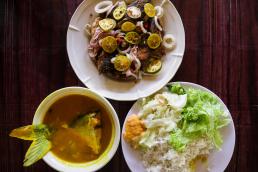
By the time we had finished both our conversation and late lunch, it was already 4 PM. As we excused ourselves, Shahriman came out from the kitchen and handed us packets of tempoyak gravy. He told us that before he went into the restaurant business and was only running the fishery, he sold tempoyak sauce alongside freshwater Patin at his road-side stall. This combination of offerings was apparently common throughout all roadside stalls in Temerloh. Shahriman had elevated that business into a restaurant, and we could not be any happier for his success.
As we drove to the Temerloh exit into the East Coast Expressway, we passed by the huge block letters of Temerloh by the riverbank. It had been almost four decades since Temerloh boomed into the Patin industry – now it’s leading player. The town was still frozen in time, defined mainly by small kampungs dotted along its expansive river network. Fisheries crowd the riverbanks, and if one comes in the mornings, they can observe the slow but methodical routine of fish rearing. Come afternoon, the town swells with visitors craving for Patin Tempoyak dishes all over – and by nightfall, the town becomes silent and desolate once more.
This is Temerloh every weekend for the past many decades. There is no immediate expectation of change. Whether it is a boom in Patin rearing production, or whether the town will see any further improvements beyond superficial façade uplifts, or a few more motels and restaurants popping up. Just like the Patin farmers and their expectations towards the trade: what they have is enough to make a living, and more importantly, an honest one.

